| April is the month for Japanese flowering cherries. Since I am updating my Trees of Seattle book, much time has been devoted to study of trees in bloom. Here, then, is an overview with preliminary status notes on those kinds of Japanese flowering cherries in Seattle. Excluded are four sato zakura cultivars known to me only in the Washington Park Arboretum. |
| The Japanese flowering cherries collectively known as sato zakura (meaning domestic, village or cultivated cherry trees grown solely for ornament), have been extensively bred for hundreds of years, so there exists a multitude differing in form, flower, fragrance, and vigor. The cultivars bloom at different times from early March through late May, with large petals pure white to creamy-yellow and all shades of pink, usually semi-double or double-flowered and usually scentless. Compared to wild cherry trees, the twigs are stout, leaves large, and branches few. The young foliage is more often than not bronze rather than pure green in color. |
| Entire books attempt to sort out, name, illustrate and tell a bit about the origin and history of the different kinds. Early in the 1900s the naming of cultivars was done differently, so botanists E. Wilson and M. Miyoshi used formæ desginations for what are in today's practice cultivars. Experts disagree on correct cultivar names for some clones (as well as orthography), and regrettably the only way to ensure understanding is to cite a horde of synonyms. Until the 1980s, these trees were treated by Westerners as cultivars of Prunus serrulata. But this is incorrect according to botanical rules, as the tree first named P. serrulata is not the parent of any of the trees usually placed under its banner. The sato zakura are of mixed parentage; some are purebred P. speciosa cultivars, others hybrids. |
Sato zakura have been grown in North America since 1862 when G.R. Hall brought 15 double-flowered cultivars from Japan. By 1933 at least 45 cultivars were in the U.S., and Paul Russel treated 40 of them fully in his book Oriental Flowering Cherries. My book North American Landscape Trees treats 75. Trees of Seattle featured 15, but as you can see below, 6 more are now known in the city. The following partly illustrated synopsis is just my preliminary enumeration of Seattle cultivars. The actual published book accounts will include specific addresses and more data. The actual trees are very beautiful. If you have feedback for me, I welcome it.
|
| P. 'Amanogawa' |
| =P. serrulata 'Amanogawa' |

'Amanogawa' Cherry photo by ALJ
|
White-Column cherry. Apple Blossom cherry. Name means "celestial river" or "milky way." Common in Seattle. Fastigiate, its stout knobby twigs and branches all grow straight upward after the fashion of Lombardy poplar. Flowers slightly fragrant, single or semi-double, of (5) 9 (15) petals, very pale pink or practically white. Young foliage slightly yellowish-bronze.
|
| P. Cascade SnowTM |
| =P. serrulata 'Berry' |
| =P. Lannesiana 'Shirayuki'? |
| =P. serrulata f. sirayuki (Koidz.) Wils.? |
Not in first edition of Trees of Seattle. Originally imported from a Japanese nursery by Rae Selling Berry (1881-1976) of Portland, Oregon. Its Japanese cultivar name was lost (but is likely 'Shirayuki'). The clone was therefore renamed and introduced to commerce in 1994-95 by Schmidt nursery of Boring, Oregon. It has been planted as a street-tree in Seattle. Pale pink buds open to pure white, single flowers, weakly scented, 1.5 to 1.75 inches wide, in short-stemmed clusters of (2) 3 (4). The individual flowerstems are lightly hairy, the sepals slightly toothed. Young leaves bronzy, contrasting prettily with the white flowers.
|
| P. 'Choshu-hizakura' |
| =P. serrulata 'Choshu-hizakura' |
| =P. serrulata f. splendens Miyoshi |
| =P. Lannesiana f. chosiuhizakura (Koidz.) Wils. |
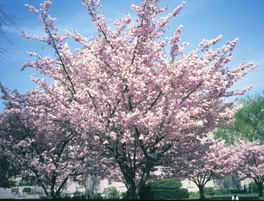
'Choshu-hizakura' Cherry photo by ALJ
|
Name means "red-" or "pink- cherry of Choshu." Buds purple-red. Flowers nearly single, of 5-7 (9) petals, deep rosy-pink, 1 and five-eighths to 2 inches wide, in loose clusters of 2-4 (6); sepals untoothed, wine-colored. Young foliage reddish-brown or coppery-red. Known only as 9 trees at the U.W. campus, and two specimens mislabeled Prunus serrulata var. spontanea in the Washington Park Arboretum. (#1-40G in 28-2W west of Azalea Way; #53-66 in 13-2E east of the pond on Azalea Way).
|
| P. 'Fugenzo' |
| =P. serrulata 'Fugenzo' |
| =P. serrulata 'Kofugen' |
| =P. serrulata 'James (H.) Veitch' |
| =P. serrulata 'Kofugen' |
| =P. serrulata f. classica Miyoshi (in part) |
| =P. serrulata f. albo-rosea Mak., non Wils. (cf. P. 'Shiro-fugen') |
| =P. serrulata f. fugenzo Mak. (in part) |
Name means "fugen elephant" (the petal tips are curved like an elephant nose) or "goddess on a white elephant." Known by the 1400s; introduced to England in 1878 by J.H. Veitch. In North American commerce since 1901 or before. Commonly listed by nurseries until recently. Extremely rare in Seattle. Tree moderately strong, broadly rounded; often with interwoven branching. Less vigorous than P. 'Kwanzan' and with a flat-headed growth habit; tree less leggy and gaunt. Crimson buds have sharply toothed sepals curled characteristically. Flowers 1 and five-eighths to 2.5 inches wide, double, (16) 25-30 (50) petals, deep pink, usually with 2 (rarely only 1) tiny leafy carpels in the middle. Among the last to bloom in spring. Young foliage with a hint of bronze. See P. 'Shiro-fugen'.
|
| P. 'Hokusai' |
| =P. serrulata 'Hokusai' |
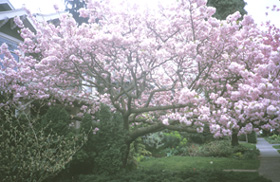
'Hokusai' Cherry photo by ALJ
|
Not in first edition of Trees of Seattle. Imported to Holland about 1866 by Siebold. Named in 1925 after the famous Japanese artist Hokusai Katsushuka (1760-1849). In North American commerce since by or before 1929. Extremely rare in Seattle. Tree wide vigorous and spreading (one in Point Defiance Park, Tacoma, was 57 feet wide in 1990). Flowers profuse, semi-double (7-20 petals), pale pink with an "orange," "apricot," or "mushroom" tinge, 1 and two-thirds to 2 inches wide, in loose, long-stemmed clusters of (3) 4-6. Young foliage pale-bronze. Very similar to P. 'Horinji' (below) and to P. 'Fuku-rokuju' (P. serrulata f. contorta Miyoshi; P. Lannesiana f. fukurokuju Wils.).
|
| P. 'Horinji' |
| =P. serrulata 'Horinji' |
| =P. serrulata f. decora Miyoshi |
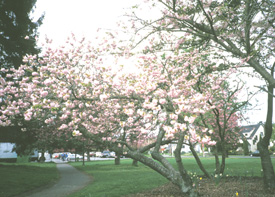
'Horinji' Cherry photo by ALJ
|
Name is of an ancient Buddhist temple in Kyoto. Extremely rare. The standard book description: Tree small, with stout, stiffly ascending branches, sparsely furnished with foliage; to 18 feet tall and 12 feet wide. Buds mauvy-pink. Flowers 1.75 to 2 inches wide, flattish, almost white in center with pinker margins; semi-double (12-20 petals); in large drooping clusters of 2-6; sepals and calyx dark purplish-brown. Blooms over a unusually long period. Young foliage greenish-brown. Leaves long and narrow.
|
In Seattle, 3 specimens labeled 'Horinji' at the Washington Park Arboretum, dating from 1940 to 1955, are matched by others in the city, but until their real name is determined they shall remain 'Horinji' because they are similar to the original tree except far stronger (one is 47.5 feet tall).
|
| P. 'Hosokawa' |
| =P. serrulata 'Hosokawa-nioi' ('Hesokawanoi', 'Hosakawanoi') |
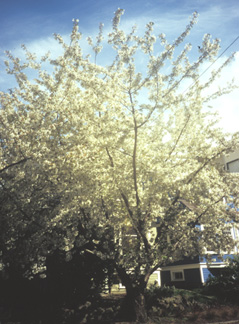
'Hosokawa' Cherry photo by ALJ
|
Not in first edition of Trees of Seattle. Named after Lord Hosokawa, a Japanese nobleman. Found in Seattle as a rare street-tree, usually in company with 'Shirotae'. Never sold under its proper name. Tree spreading, to 15 feet tall or more. Buds faintly pink. Flowers single or nearly so, pure white, notably fragrant, to 1.5 inches wide in rather long-stemmed clusters of 3Ð6; sepals sharply toothed. Young foliage yellowish-brown, soon green.
|
| P. 'Kiku-shidare-zakura' |
| =P. serrulata 'Kiku-shidare-zakura' |
| =P. serrulata 'Cheal's Weeping Cherry' |
| =P. serrulata 'Double Pink Weeping' |
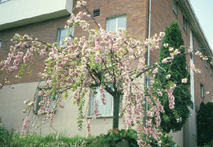
'Kiku-shidare-zakura' Cherry photo by ALJ
|
Name means "weeping chrysanthemum cherry." Common. A small tree, noted at most 13 feet tall, arching and more or less weeping from a topgraft. Tends to be gawky and thinly furnished. Flowers medium-sized, extremely double, with 50-70 (110) petals, dark pink. Young foliage faintly bronze, very soon green. Leaves dark, narrower than those of most sato zakura, and exceptionally glossy; prominently edged with incised teeth; stem rich red.
|
| P. 'Kwanzan' |
| =P. serrulata 'Kwanzan', 'Kanzan' or 'Kansan' |
| =P. serrulata 'Sekiyama' |
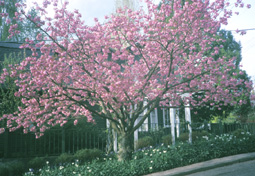
'Kwanzan' Cherry photo by ALJ
|
Both the 'Kwanzan' and 'Sekiyama' names refer to the same sacred mountain in China. The most common of all sato zakura. Tree strong and massive (one in Seattle is 53 feet tall); more cold-hardy than most sato zakura. Flowers large, double, with 20-30 (50) petals, dark rosy-pink, fading in time; sepals untoothed. Young foliage dark bronzy-red. Leaves very large. Fall color can be pleasing peachy-orange from a distance. Being so widely cultivated, with so many synonyms, there is considerable variation in vigor, color and time of blooming in stock from nurseries.
|
| P. 'Mikuruma-gaeshi' |
| =P. serrulata 'Mikuruma-gaeshi' |
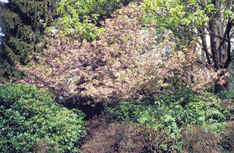
'Mikuruma-gaeshi' Cherry photo by ALJ
|
The name means "the royal carriage returns." Extremely rare: known currently as a lone individual at Green Lake, 21.5 feet tall, near the theatre. Tree stiffly upright; long ascending branches covered with short flowering spurs. In age, habit decidedly spreading. Blooms about 10 days before P. 'Kwanzan'. Buds pointed, deep carmine-pink, sepals untoothed. Flowers single, rarely with an extra petal or two, lightly fragrant, profuse, very pale pink or white above, pinker below, 1.5 to 2 inches wide, flat, in short-stemmed clusters of 2-4. Young foliage bronzy-green. Fruit often formed; pea-size, blackish-purple, no good to eat, yet viable.
|
| P. 'Ojochin' |
| =P. serrulata 'Ojochin' |
| =P. serrulata f. bullata Miyoshi |

'Ojochin' Cherry photo by ALJ
|
The name means "large paper lantern." Very rare. Tree strong, to 30' tall or more, broadly spreading or rounded. It branches from 3 or 4 feet above the base and develops a broad, compact crown; very floriferous. Flowers weakly fragrant, single or semi-double, 5-10 (13) large wrinkled petals, whitish with a hint of pink, borne as many as 8 per cluster. Each flower up to 2.25 inches wide, much like those of P. 'Tai Haku'. Young foliage bronzy-green, many leaves rounded instead of long-tipped. Leaves large, to 10 inches x 4.25 inches.
|
| P. 'Pink Perfection' |
| =P. serrulata 'Pink Perfection' |
Not in first edition of Trees of Seattle. Raised in 1935 by Waterer, Sons & Crisp nursery of Bagshot, England. A seedling of P. 'Shogetsu', the pollen parent thought to be P. 'Kwanzan'. In North American commerce since 1959Ð60 or before. Very rare in Seattle. Tree broadly vase-shaped. Buds light red. Flowers pink, in April-May, double (about 30 petals). Young foliage pale bronze.
|
| P. 'Royal Burgundy' |
| =P. serrulata 'Royal Burgundy' |
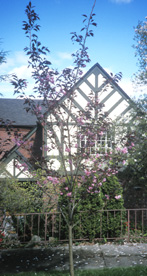
'Royal Burgundy' Cherry photo by ALJ
|
Not in first edition of Trees of Seattle. A mutation from P. 'Kwanzan' discovered by Frank Parks of Speer and Sons nursery, Woodburn, Oregon. In commerce since before 1990. Leaves purplish-black; their fall color reddish-orange.
|
| P. 'Shiro-fugen' |
| =P. serrulata 'Shiro-fugen' |
| =P. serrulata f. albo-rosea Wils., non Mak. (cf. P. 'Fugenzo') |
| =P. serrulata f. classica Miyoshi (in part) |
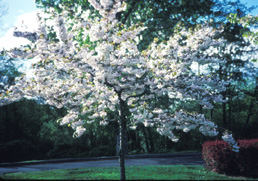
'Shiro-fugen' Cherry photo by ALJ
|
Name means "white god" or "white red." The Japanese common name for this cultivar is Fugenzo. If 'Shiro-fugen' is, as attested by certain writers, really a synonym of 'Fugenzo' then I need to find out the proper name for the Seattle 'Fugenzo' specimens. Common. Tree broad and strong, with relatively slender twigs. Buds deep pink. Flowers large, double (20-36 petals), first soft pink, then white, then fading pink-cerise in age. Two (or as many as five) tiny leaflike carpels in the middle. Late-blooming compared to most sato zakura. It has a habit of blooming again, sparsely, in mid-June or early July. Young foliage coppery-red.
|
| P. 'Shirotae' |
| =P. serrulata 'Shirotae' |
| =P. serrulata 'Mt. Fuji' or 'Mount Fuji' |
| =P. serrulata f. albida Miyoshi |

'Shirotae' Cherry photo by ALJ
|
Name means "snow white" or "snowflake." Common. Sometimes P. 'Shogetsu' is supplied under this name (and almost certainly 'Hosokawa' also). Usually a vigorous, very strongly spreading tree, wide and low. It may be recognized any time of year by its flat-topped, horizontal growth. Flowers lightly fragrant, semi-double, 5-11 petals, pure white (except for sometimes a faint pink blush when first opening), appearing earliest of all: early March. Young foliage green. Leaves edged by delicate long-fringed teeth.
|
| P. 'Shogetsu' |
| =P. serrulata 'Shogetsu' |
| =P. serrulata 'Shimidsuii' or 'Shimidsu (-zakura)' |
| =P. serrulata f. superba Miyoshi |
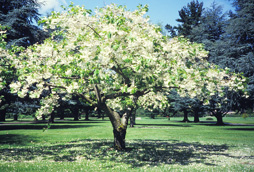
'Shogetsu' Cherry photo by ALJ
|
Name means "moonlight thru pine branches," or "moon hanging low over a pine," or "fairy queen." Common. Tree weak, delicately drooping, wide-spreading. Buds apple-pink. Flowers double (20-30 petals), large (to 2 and three-eighths inches wide), white, with 1 or 2 tiny leaflike carpels in the middle. They are long-stemmed (to 2.75 inches) and dangle in clusters altogether about 6 inches long, blooming late in spring and long persiting, fading to pale pink near the end of their tenure. Young foliage green.
|
| P. x Sieboldii (Carr.) Wittm. |
| =P. serrulata 'Takasago' |
| =P. serrulata 'Naden' hort. p.p., non Miyoshi, non Mak. |
| =P. serrulata f. Watererii Mak. |
| (P. apetala x P. speciosa) |

Prunus x Sieboldii Cherry photo by ALJ
|
Naden cherry. Japanese: Naden or Musha Zakura. The Takasago name refers to a classical song that praises the cherry blossoms of Takasago Island (Taiwan). Others say Takasago means "Good health and long life." Often considered in the sato zakura group. Imported to Holland from Japan by Siebold about 1862-64. Named in 1866 after Philipp Franz Balthasar von Siebold (1796-1866). Siebold lived in Japan from 1823 to 1830, and introduced many Japanese plants to Europe.
|
Uncommon. More cold-hardy than most sato zakura. Flowers medium sized, single or (usually) semi-double (9-15 petals), pale pink, borne in compact clusters like snowballs; fragrant. Occasionally the flowers and leaves develop at the same time, in which event the flowers are paler, almost white, and more nearly single, with longer common stalks (peduncles). Young foliage yellow-brown to reddish-bronze, coated on both sides with persistent, fine hairs. Growth very slow; congested and twiggy.
|
| P. 'Tai Haku' |
| =P. serrulata 'Tai Haku' |
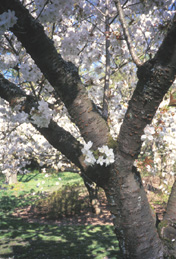
'Tai Haku' Cherry photo by ALJ
|
Name means "great white cherry." All specimens in Japan had died, but one dating from 1900 remained alive in England and saved the variety from extinction. In North American commerce since 1934 or before. Uncommon. A strong tree, up to 40 feet tall. Buds palest pink. Flowers single, pure white, to 2.5 inches wide (largest of any sato zakura). Young foliage deep copper. Leaves large, to 9.25 inches x 4 inches, with attractively fringed teeth on the edges.
|
| P. 'Taizan-fukun' |
| =P. serrulata 'Taizan-fukun' |
| =P. serrulata f. ambigua (Miyoshi) Ingram |
| =P. x Miyoshii 'Ambigua' |
Name means "god of Taizan Mountain" (in China). Since several specimens at the Locks died, this is now known in Seattle only as a lone 1962 accession in the Washington Park Arboretum, on the east side of Azalea Way in 19-1W. Tree erect and flaring vase-like; small. Flowers pale pink, double (36-49 petals), small (1 and five-eighths to and seven-eighths inches wide), on scantily hairy stems about 1" long; scentless. Floral parts, young twigs and leaves lightly hairy. Young foliage bronze. Leaves small for sato zakura, underside shiny, stem hairy, fall color brilliant reddish, purple and yellow. Differs from Yoshino cherry (P. x yedoensis) in bearing smaller, thinner, less glossy leaves; blooming later, and is less hairy.
|
| P. 'Tanko-shinju' |
| =P. serrulata 'Tanko-shinju' |

'Tanko-shinju' Cherry photo by ALJ
|
Not in first edition of Trees of Seattle. Name means "pink pearl" or "two people commit suicide in a coal mine." In North America since before 1920; named here; in commerce since before 1929; commercially extinct. Extremely rare in Seattle. Of moderate vigor, vase-shaped at first, ultimately a spreading 25' tall tree. Buds mauve-pink. Flowers fluffy, of about 10-17 twisted petals, broadly rounded, only notched once; very pale pink at center, often with a pink eye in age, deep pink at margins; to 2 inches wide, in long drooping clusters of 2-6 as globular masses bunched towards ends of branches. The clusters are markedly long-stalked. Sepals untoothed, relatively broad. Young foliage bronzy. Similar to P. 'Fuku-rokuju' and P. 'Horinji'.
|
| P. 'Temari' |
| =P. serrulata 'Temari' |
| =P. serrulata f. globosa Miyoshi |
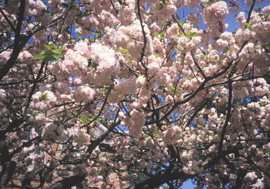
'Temari' Cherry photo by ALJ
|
Name means "ball," referring to the flower clusters. Uncommon. Tree broadly rounded, of moderate strength. Buds deep red. Flowers double, (15) 20-25 (30) petals, pale pink, with some leafy carpels in the center; in compact, heavy balls. Young foliage tardy to appear, very faintly bronze, essentially green. Leaves often rounded at apex.
|
| P. 'Ukon' |
| =P. serrulata 'Ukon' |
| =P. serrulata f. grandiflora Wagner |
| =P. serrulata f. luteo-virens Miyoshi |
| =P. serrulata f. viridiflora Mak. |
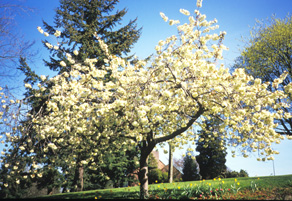
'Ukon' Cherry photo by ALJ
|
Name means "yellowish." Common. Also called the green cherry. Tree tall, rounded and strong; more cold-hardy than most sato zakura. Flowers semi-double, with 5-14 petals, at first creamy-white or pale yellow with green tones, fading to red in the center. Young foliage light bronzy-green. Fall color can be purple or rusty-red.
Back |

